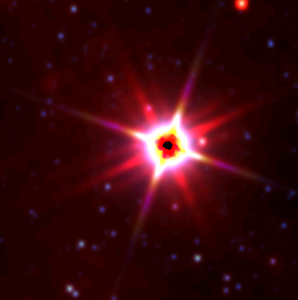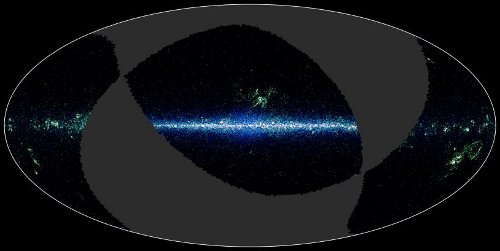
Data from the first 57 percent of the sky surveyed by the WISE mission (Wide-Field Infrared Survey Explorer) are now available and accessible through the online archive. You can dig into the archive hunting for WISE imagery right now, as I did this morning to retrieve this Alpha Centauri image. The WISE team has put up a help page on the image data service with useful information about how to find and work with color images. The method is straightforward: You enter a name or set of coordinates for stars, nebulae or galaxies, choose the size of the image to retrieve (the defaults bring you images from each of the four WISE detectors), and select three of the four WISE bands to pull up a color image that combines their results.
Play around with the help page a bit and you’ll quickly become familiar with the setup, and there is further help available within the archive itself. We have much more to come from WISE, with the complete survey, including improved data processing, scheduled for release about a year from now. But thus far the early count from WISE is rich, including nearby objects ranging from twenty comets to over 33,000 asteroids between Mars and Jupiter and 133 Near-Earth Objects. And in the deep sky, the haul is huge. Says Fengchuan Liu, project manager for WISE at the Jet Propulsion Laboratory:
“We are excited that the preliminary data contain millions of newfound objects. But the mission is not yet over — the real treasure is the final catalog available a year from now, which will have twice as many sources, covering the entire sky and reaching even deeper into the universe than today’s release.”
We now move toward making these objects available to astronomers for follow-up study, meaning that, as principal investigator Ned Wright puts it, “Starting today thousands of new eyes will be looking at WISE data, and I expect many surprises.” Leaning about new brown dwarf discoveries in the neighborhood of the Sun is certainly high on my list of interests, as is resolving the issue of whether a large object in the inner Oort Cloud could be disrupting cometary orbits there. The useful thing about surveys is that they turn up surprises because they’re open to the entire sky, rather than focusing on a single set of targets. You can be sure that the most intriguing WISE discoveries will be fodder for quick follow-up observations by other observatories.

Image: A map of the portion of the sky covered by the preliminary release of WISE data. The fuzzy line down the middle is our Milky Way galaxy, and bright clouds are star-forming complexes. The gray regions are the part of the sky not available in the preliminary WISE data release. For the regions with data, the colors used are representational: blue and cyan (blue-green) represent data from the 3.4- and 4.6-micron detectors aboard WISE, and green and red represent data from the 12- and 22-micron detectors. The blue and cyan reveals mostly light from stars, while the green and red come from mostly warm dust. Credit: NASA/JPL-Caltech/UCLA.
WISE scanned the entire sky while collecting images taken at four infrared wavelengths of light accumulating a total of over 2.7 million images. And although its hydrogen coolant ran out in October of last year, two of its four infrared channels remained operational for an extended mission covering four more months, sweeping for asteroids and comets in the main asteroid belt. The satellite is now in hibernation, but astronomers here on Earth will be busy for years looking for the hidden gems WISE has uncovered. And as they go to work on new data, be aware that the first six of eighteen segments forming the James Webb Space Telescope’s primary mirror will begin final cryogenic testing this week. Things can seem to move at a glacial pace when we’re anticipating new discoveries, but step by step we’re getting there.



Thanks Paul for the up to date info (as usual) on this gem of an archive. The web programmers have my respect. The visualization of the data is amazing and the interface is easy to use.
Now, let us hunt for Tyche ;)
Are there any plans announced for sifting through the data for Dyson Shells and similar astroengineering projects?
So, did they find Nemesis or Tyche or whatever its called? What else did they find in the “near abroad” (the space out beyond the Kuiper belt, but still in the solar system)?
What we’ve got at this point is a large amount of data, which will now have to be mined and culled for objects of interest. So it’s too early to say what we’ll find out in the Oort, and I don’t know about SETI possibilities re Dyson shells, etc. either. The main thing is that all this material is now available for scrutiny, and time will tell whether we can weed out a nearby brown dwarf or an object in the Oort.
The WISE team has had a year to purview that data. I expect papers will be submitted anytime now. What will be the discoveries announced in those papers? Many brown dwarfs, not so many brown dwarfs? What else?
Inquiring minds and planet formation theorists want to know. And ofcourse the findings can be examined by any astronomer or anybody else who is interested.
Another goldmine of data released for everybody to use. A very close second in interest only to the Kepler data release in my opinion.
It will take a while to sort out the data, and along with waiting for the full mission data later. SOO.. in about a year and a half form now, maybe there will be enough excitement to fund ( privately?) a restart of the WISE telescope. That would mean getting some proper motion studies on anything big, brown and within a light year or so. that would allow more interesting objects to be pulled out of the stack. In the meantime most the most obvious targets will have the Spitzer and Hubble available, as well as Earthbound ‘scopes for 2 micron and visible. lots of work to match these up to the Sloan, 2 micron, and Panstarrs survey data! With the delays in WFIRST and with the much narrower field JWST , looks like WISE may be the only game in town for a while! A 6 to 8 million dollar project to get another 13 months of Data at the two shorter wavelengths looks more and more like a bargain , and maybe the best option while waiting for 2018 or even 2020 for another infrared scope!
Well, 5 late T dwarfs were announced last week from WISE data. Its the trickle before the rush hopefully:
http://arxiv.org/pdf/1104.2537
P
Nice to see that NGC 5907 is included in this collection:
http://www.universetoday.com/85976/through-the-eyes-of-wise-galaxies-seen-in-a-new-light/